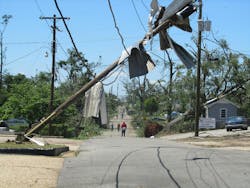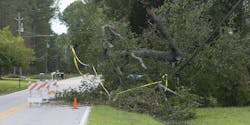By the end of this decade, the North American smart city market will be worth close to $1 trillion, a roughly fourfold jump from 2024, Grand View Research predicts. A new standard from NEMA’s Lighting Systems Division should help electrical contractors and electrical design firms grab a share of that burgeoning market by leveraging upgrades aimed at bolstering outdoor lighting resiliency. ANSI/NEMA C137.10-2024 creates a vendor-agnostic format for data produced by sensors installed on light poles along roadways and pedways. That standardization enables municipalities, utilities, and other lighting infrastructure owners to have a mix of hardware and software vendors without risking data incompatibility.
“All of those different sensors come with the risk of measuring and reporting data in their own format,” says Patrick Hughes, NEMA senior vice president of technical affairs. “This is meant to standardize the ability for these to report into a common software platform in the same way.”
Also known as the “Lighting System Sensor Data Model Standard,” ANSI/NEMA C137.10 is the latest in a trio to help maximize the resiliency of outdoor area lighting. NEMA/ANSI C136.2, released in January 2024, covers minimum performance requirements and test procedures for evaluating luminaire and control devices under test for dielectric withstand and electrical transient immunity. NEMA/ANSI C82.77-5, published in October 2023, specifies voltage surge limits and testing requirements for lighting equipment.
“A lot of the streetlight infrastructure in North America is using the NEMA standard [family],” says Dan Evans, Itron director of smart cities. “NEMA is technically the ANSI standard for the receptacle that does the lighting control.”
ANSI/NEMA C137.10 can be used for recording and sharing data both from a luminaire’s networked lighting control (NLC) unit and from sensors that attach to it. The NLC itself helps increase resiliency by identifying poles that are tilted or fallen due to wind or vehicles.
“All of the NLCs on the market include tilt,” Evans says. “That doesn’t necessarily leverage the C137.10 standard. But when you talk about adding a flood sensor or something separate from the lighting control itself, that’s where C137.10 comes into play.”
There are several ways that real-time sensor data can increase resiliency, starting with the ability to identify exactly which lights are being affected by a storm. This enables crews to be dispatched directly to those locations — and ideally, before customers start calling about outages and downed poles. That’s helpful from both a taxpayer and regulatory perspective if it makes the municipality or utility look like it’s always on top of things during hurricanes, ice storms, and other natural disasters. Sensor data also can help with preventative maintenance so lighting is better able to withstand storms and vehicle strikes.
“We’ve heard from a lot of municipalities that the maintenance piece is a huge issue for them,” says Chris Wolgamott, Northwest Energy Efficiency Alliance senior product manager. “This can help mitigate some of that. It’s not a cheap venture to go out to check on a light. You have to roll out two or three people if you have to stop traffic. The data can help them be able to do that at a time that maybe it isn’t as expensive or they can group them.”
Bright ideas
The storm scenario highlights how technologies deployed for lighting resiliency can support smart city applications, too.
“Let’s say that a certain number of poles in an area have detected a flood,” says NEMA’s Hughes. “The city could use that information to get an alert out to citizens: ‘Floods are coming. Please evacuate.’ Or it could be high winds from a hurricane, and you’re starting to see property damage. You could use that as an indicator to warn people to go to their basements.”
North America is home to about 64 million streetlight poles, according to the research and consultancy firm Arthur D. Little. This ubiquity puts them in the ideal places to facilitate many smart city applications, such as sensors for detecting gunshots and counting vehicles or pedestrians.
“You could use these poles to detect CO2 levels or pollutants — things that could be asthma triggers and use that to maybe target clean air initiatives,” Hughes says. “If you can tell that one ward of the city is experiencing higher-than-normal asthma rates, and you can detect a lot of air pollutants, then you can look at what’s around there. Maybe there’s a fleet of trucks [idling there], and that could be prioritized for electrification and improving health outcomes and greenhouse gas emissions.”
Many cities own parking lots and metered spaces along streets, some of which have created smartphone apps to help drivers quickly find open spots so they don’t increase pollution and gridlock by hunting all over. Light poles could be another means to the same end.
“In an airport parking lot, you have sensors that can tell if a spot is occupied,” Hughes says. “Nothing is stopping you from deploying something similar in light poles to flag open parking spots in the city.”
ANSI/NEMA C137.10 sensor data could be used to avoid pedestrian traffic jams, too, as one U.K. city did with the streetlights in the neighborhoods around its stadium.
“They would use the lights to dictate where foot traffic would go,” says Northwest Energy Efficiency Alliance’s Wolgamott. “If [one route] got too crowded, they would start turning lights on side streets to direct how to get to the stadium.”
Big data and the big picture
That’s a lot to consider, which highlights the role that electrical contractors and electrical design firms can play in educating municipalities about how ANSI/NEMA C137.10 can support a wider range of applications than they considered when drafting their RFPs.
“We may not know what to do with all this data today because it’s new,” Wolgamott says. “But if you put [the sensors] in, you’ll start to know. There’s going to be stuff a year from now that we never thought of.”
It helps to take a holistic view of the city’s goals and pain points rather than focusing on a single department’s requirements.
“A likely scenario is a city realizes that their outdoor lighting infrastructure is dated, and they want to replace it,” Hughes says. “That might be one part of the local government, and then you’ve got some other part that’s in charge of smart cities. They’re probably not talking to each other. This could be an opportunity for a contractor to say, ‘Have you thought about leveraging this ubiquitous network of electric poles to do something more than just illumination?’ Contractors that understand the art of the possible could educate customers and help them get more out of that investment.”
Manufacturers agree.
“When we think about who we’re engaging at the city, we know their departments are very much siloed,” says Itron’s Evans. “They make decisions for their own sake. The lighting department is making decisions for the lighting department, and they frankly don’t care about the water department or the traffic department.”
One strategy is to ask the department that issued the RFP to invite city leadership to meetings.
“A city manager or a chief information officer or a chief sustainability officer is that audience who kind of sees the forest for the trees and goes: ‘Hold on. If we’re going to invest in technology, let’s make sure it’s benefiting all departments, not just one,’” Evans says. “That could start to influence decisions that get made within the departments themselves.”
Another way that a holistic approach can make sales is because now the project doesn’t depend entirely on a single department’s budget. ANSI/NEMA C137.10’s vendor-agnostic design can play a key role.
“As long as they see it as a platform that they’re investing in at the city level, then those messages will begin to resonate,” Evans says. “They’ll be looking for things like these standards to say: ‘We want to do all of that. Let’s make sure we’re picking vendors who support the standards so that we aren’t locked into a particular vendor.’”
Networked lighting also can support a smart city’s sustainability goals, such as reducing its carbon footprint by reducing streetlight energy consumption.
“The types of sensors addressed in C137.10 are not directly related to energy efficiency, so they are not addressed in DesignLights Consortium Technical Requirements,” says Levin Nock, DLC senior technical manager. “These sensors could be indirectly related to energy efficiency if their benefits justify the installation of more NLC systems, and then those NLC systems are used to save energy. In my opinion, any reason to install NLC systems is a good reason because once they are installed, they can be used to save electricity. [They also can] reduce light pollution using high-end trim, scheduling, part night dimming, and seasonal dimming during annual bird migrations.”
One example is adding sensors that detect when vehicles and pedestrians are not nearby. Those fixtures can then dial down their illumination, which reduces energy consumption, carbon emissions, and light pollution.
Despite these benefits, energy efficiency probably won’t be the top motivation for investments that leverage ANSI/NEMA C137.10.
“Energy efficiency is not one of the top 10 things you talk about to sell controls,” Wolgamott says. “It’s the thing that helps pay for it, but it’s not the thing that sells it.”
Sizing up the opportunities
One drawback of a $1 trillion market forecast is the potential for lots of startups and other vendors parachuting in and then flaming out — a cautionary tale from the equally hot solar sector, where more than a thousand manufacturers have failed. ANSI/NEMA C137.10 mitigates that risk to some extent, and, in turn, could lead to projects that otherwise would have been delayed or scuttled over fears about vendor lock-in.
“In the smart cities, space you worry: ‘Is this vendor going to be in business in five years? Am I investing in a stranded asset?’” Hughes says. “Having a common standard where they’re reporting and communicating the data in the same way helps a municipality become more [aggressive] adopting smart city technologies.”
ANSI/NEMA C137.10 also benefits vendors and systems integrators, including electrical contractors and design firms playing that role.
“The benefit to the marketplace is that smart city software can be written by one company to accept data from various NLC systems built by various other companies, without reinventing the wheel for each different NLC system,” says DesignLights Consortium’s Nock. “A smart city software company can focus on product excellence rather than wasting time rewriting interface code over and over for every different NLC system. Conversely, an NLC manufacturer can focus on NLC excellence rather than wasting time rewriting interface code over and over for every different smart city software product.”
Although ANSI/NEMA C137.10 is aimed at area lighting owned by municipalities and utilities, nothing says it can’t be used for large-scale commercial and industrial lighting networks, such as stadium parking lots and college campuses.
“There’s a segment, what I call area lighting, which is private enterprises: big box stores, etc., which is probably a market that’s just as big as roadway in North America,” says Itron’s Evans. “The potential is that C137.10 can be applied to any of those.”
This opportunity depends partly on the existing infrastructure. For example, if a shopping center’s parking lot luminaires are all connected to a central switch, then they probably won’t each have a NEMA receptacle to accommodate an NLC. But if the shopping center owner wants to upgrade all of the lighting anyway, such as from metal halide to LED, then it opens the door to sensors compatible with ANSI/NEMA C137.10.
This June marks one year since ANSI/NEMA C137.10 was published, and it probably will be another year before the implementation starts to scale up.
“2025 is not going to be the year where you see a huge adoption,” Evans says. “It’s still a nascent market. Cities, utilities, and even private enterprises that have some of these use cases might start with a pilot or a particular neighborhood to kick tires. That makes a lot of sense. They can’t build the business case to go spend the money unless they know it’s going to get the results and the return on the investment.”
About the Author
Tim Kridel
Freelance Writer
Kridel is an independent analyst and freelance writer with experience in covering technology, telecommunications, and more. He can be reached at [email protected].



